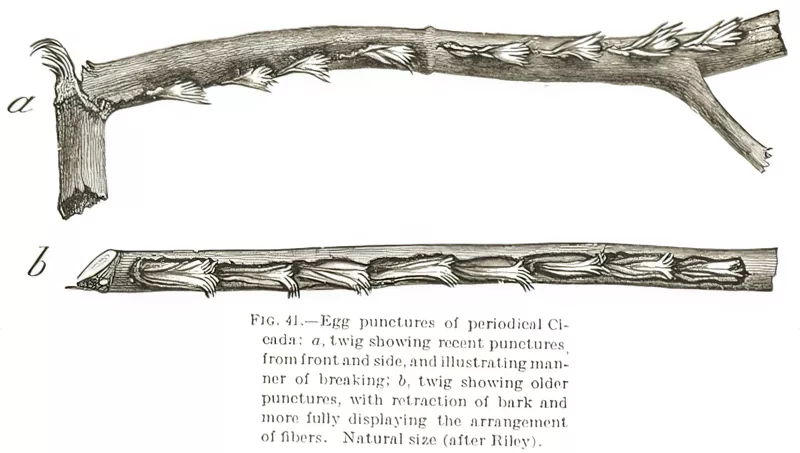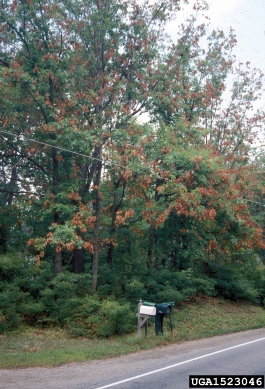Cicadas and Temperature
Cold weather across the U.S. seems to have slowed the Magicicada emergence. It is true that cold temperatures will deter nymphs from emerging, and stop adult cicadas from flying around and singing. Cicadas are “cold-blooded” so they rely on air temperature and direct sunlight to warm up, and unless their bodies are warm enough, they won’t be able to fly, sing and mate. The black skin color of Magicicadas helps them warm up, just like how a black leather seat in a car gets hot to the touch in the summer.
Soil temperature is one of the indicators of when periodical cicada nymphs will begin to leave the ground. Typically they will start to emerge once the soil temperature reaches 18°C / 64°F or warmer (8″/20 cm beneath the soil surface).
Their body temperature needs to be a little warmer than that to fly. Their minimum flight temperature (MFT) is 18-21°C / 65-70°F. The temperature varies depending on the Brood and species. They’ll need a few more degrees before they’re fully functional, and start singing and mating.
Maximum voluntary tolerance temperature (MVT) for periodical cicadas is 31-34°C / 88-93°F, again depending on Brood and species. Maximum voluntary tolerance is the point at which cicadas seek shade and when thermoregulation takes precedence over other behaviors.
So, until their bodies are about 72°F (“room temperature”) they won’t be flying, singing and mating.
See Thermal responses of periodical cicadas: within and between brood parity (Hemiptera: Cicadidae: Magicicada spp.) and Thermoregulation by Endogenous Heat Production in Two South American Grass Dwelling Cicadas (Homoptera: Cicadidae: Proarna) for more information.
The damage they do
Cicadas don’t cause damage to trees by chewing leaves like other insects do. Instead, the damage is caused because they lay their eggs in grooves in the branches of trees. Cicadas are technically parasites of the trees, and they need the trees to survive throughout their entire life cycle, so killing trees is not in the cicadas best interest.
The weakest limbs of a tree are often temporarily damaged or killed off, the result of which is called flagging, as the leaves of the branch will turn brown and look like a flag. They are doing the trees a favor by pruning their weakest branches.
Young trees, ornamental trees, and fruit trees will be more prone to damage as they are typically smaller and weaker than older native hardwood trees. I recommend placing netting around these trees and picking the cicadas off by hand if you’re concerned. Spraying them off the trees with a hose seems to work as well. I don’t recommend filling a bucket with cicadas and dumping them in your neighbor’s yard, as they can fly back to your yard, and your neighbor will become enraged.
The blue tape works well too: check out this photo of cicadas that can’t make it past the tape.
Grooves made by a cicada:

An image of Flagging caused by cicadas:

Do cicadas stink?!
Cicadas do stink, but only once they’re dead and rotting, like most creatures. When you get a pile of dead, wet cicadas they can kick up a serious funk, like putrefying bacon. It’s best to rake up their corpses ASAP, shovel them into a bucket or wheelbarrow, and then bury them, compost them, or use them for catfish or critter bait. Individual cicadas make excellent fish bait.
What do cicadas eat?
Cicadas don’t eat by chewing up leaves; instead, they drink their meals. Cicadas use their mouthparts to tap into trees and drink tree fluids called xylem. Occasionally you’ll see cicadas piercing a branch with their mouthparts to take a drink. They aren’t particularly smart, and occasionally mistake people for trees. Luckily cicadas are not venomous.
Do cicadas pee?
Yes, cicadas regularly pee to eliminate excess fluid. Allow me to recommend wearing a cicada hat.
Are cicadas attracted to the sound of lawnmowers and other machinery?
Yes, cicadas are attracted to the sound of lawnmowers, weed whackers, hedge trimmers, etc. Female cicadas think that these machines are males singing, and male cicadas show up to join the other males in what we call a “chorus”.
Why are there so many periodical cicadas?
Their strategy is called “predator satiation”. They reproduce by the millions in order to fill predators up. The idea is that all the squirrels, birds, possums, snakes, lizards, raccoons, varmints, teenagers and other predators will be so full of cicadas and tired of eating them, that a just enough cicadas will escape and get to mate and reproduce.
Think of it this way: Aunt Betsy and Uncle Steve always show up to the barbecue and eat up all the best cuts of meat; few if any meat escapes them. What you want to do is fill Betsy and Steve up with cheap snacks like pork rinds, chips, and Coke, so some of the meat will escape their grasp.
How long do they live?
Adults can live a few weeks, but they often don’t get to live that long, as many are born crippled, they get infected with mold, they run out of energy, they get eaten, etc.
An emergence can last locally up to 6 weeks from start to finish. They should all be dead six weeks after you see your first cicadas.
About 98% of cicadas die within the first two years of life. Imagine if they all survived to adulthood! There would be 4800% more of them.
What eats them when they’re underground?
When they’re underground they’re often eaten by moles, but enough of them escape the moles to survive.
Stragglers
If you have a lot of cicadas today, chances are you’ll have a couple next year. Not a lot, just a couple that forgot to emerge this year.
Other ideas to help you enjoy Brood XIX
- You preserve them in lucite. Here’s a basic how to article.
- You can save their nymph skins or wings, as those parts don’t rot as easily at the body.
- You can color a cicada with crayons or markers, or just draw your own.
- You can make cicada inspired crafts and sell them on Etsy.
- Spend an afternoon reading cicada research papers on Cicada Central.
- Report your cicada sightings to Magicicada.Org.
8 replies on “Periodical cicada fun facts to help you survive a cicada invasion”
I live in Northern Kentucky and I have had the pleasure of not one, but TWO, freakin’ CICADAS in my house…. One was in the bottom of the water heater, killed the pilot light, but lived to tell about it by his singing!!!!! Then last night, INVADER #2 showed up in my KITCHEN EXHAUST FAN!!!!!UGH!!!
I have not heard the one in the water heater, but the one in the exhaust fan (In the ceiling of a 1950’s house) has been singing off and on all day. My son and I tried to kill it, but the antiquated exhaust fan has a housing case with an itty bitty hole that my son sprayed bug spray to bomb the sucker. (You know, like when you bomb your house for fleas or roaches.) Oh, since my kid has a wicked sense of humor, he decided to name it, “FREDERICK”.
The fan is NEVER used until today.(I turned the fan on hoping it would guillotine the darn thing.) Nope. (I think we used it once when we first moved in 12 years ago.) So, fumigating the damn thing is not a problem if you were concerned about it being a hazard. (Now, in the case of the water heater, I had to AVOID using bug spray because of the volatility of both.) 😉
Since “FREDERICK” is still ALIVE, and I don’t want to burn my house to the ground, since I paid it off last fall, what is the BEST way to kill “FREDERICK”??
Also, no one has ever really answer the question of, “How long do CICADAS live IN YOUR HOUSE?”. Are they like houseflies and live for 3 days??? Or do they live forever???? They are very loud around here, but the highway noise can be a little louder at times…just looking for a positive outcome.
I saw that they don’t like the cold, so, I turn my thermostat down to 67 degrees. I will have to deal with FRED chirping until morning when it become freezing cold in my house. Is this a good option? I don’t want to seize up my new air conditioner because of FRED. I also read that tea tree, peppermint, lavender oils with vinegar and water work well, but that does me no good at 11:45 PM.
The big take away currently is that I have to really tighten up my vents and other areas of my house. So ANY suggestions, would be most helpful and greatly appreciated!!!!!
PS – I did notice that over the past few months that I was getting visits every night from STINK bugs. However, when BROOD X came to town, I have not seen one to date. I’m assuming that they don’t like the CICADAS either and split town. Thought this phenomena was odd and hoping they will never return, but I’m not that lucky.
I was told that a cicada has to mate in order to die. Is that true?
Also, at what point should I expect the peak emergence to occur? Is it 2-3-4 weeks after I see the first cicada?
The first question is false. They die as soon as they are killed (by another animal or accident), or once their fat stores run out. They’re like little batteries — once they run out of stored energy, they’re done.
The answer to the second question depends on the weather. Each emergence is different. With an emergence with perfect weather — high 70s/low 80s, and some rain here and there — and they’ll hit peak quicker. Let’s say 2 weeks. An emergence with bad weather, which can be too cold and wet or even too hot and dry, can extend an emergence. In this case it could take 3 weeks, maybe longer.
When outside, are there certain colors you should avoid wearing to keep cicadas from flying around you?
Tree colors? Not sure. They’re attracted to sound.
I moved into a apartment complex in kennesaw Georgia and there are thousands singing every where in the trees. Will these things try to get in my apartment when cold weather gets here? I HATE bugs so this is a HUGE concern of mine
Sorry to hear you hate bugs Brenda. The answer is: no, cicadas won’t try to get in your apartment when cold weather approaches. Adult cicadas die off the same year they emerge from the ground, usually well within the summer months, and so they have no reason to seek shelter during winter months. It is the stink bugs you have to worry about.
And don’t forget that you can go to http://www.magicicada.org and report the locations of emergences you observe to help ongoing research into their distributions. The website is working very well, sort of a “Wikipedia for Magicicada”. Many members of the general public have added their data, and those of us in the field are making use of the real-time info this year.